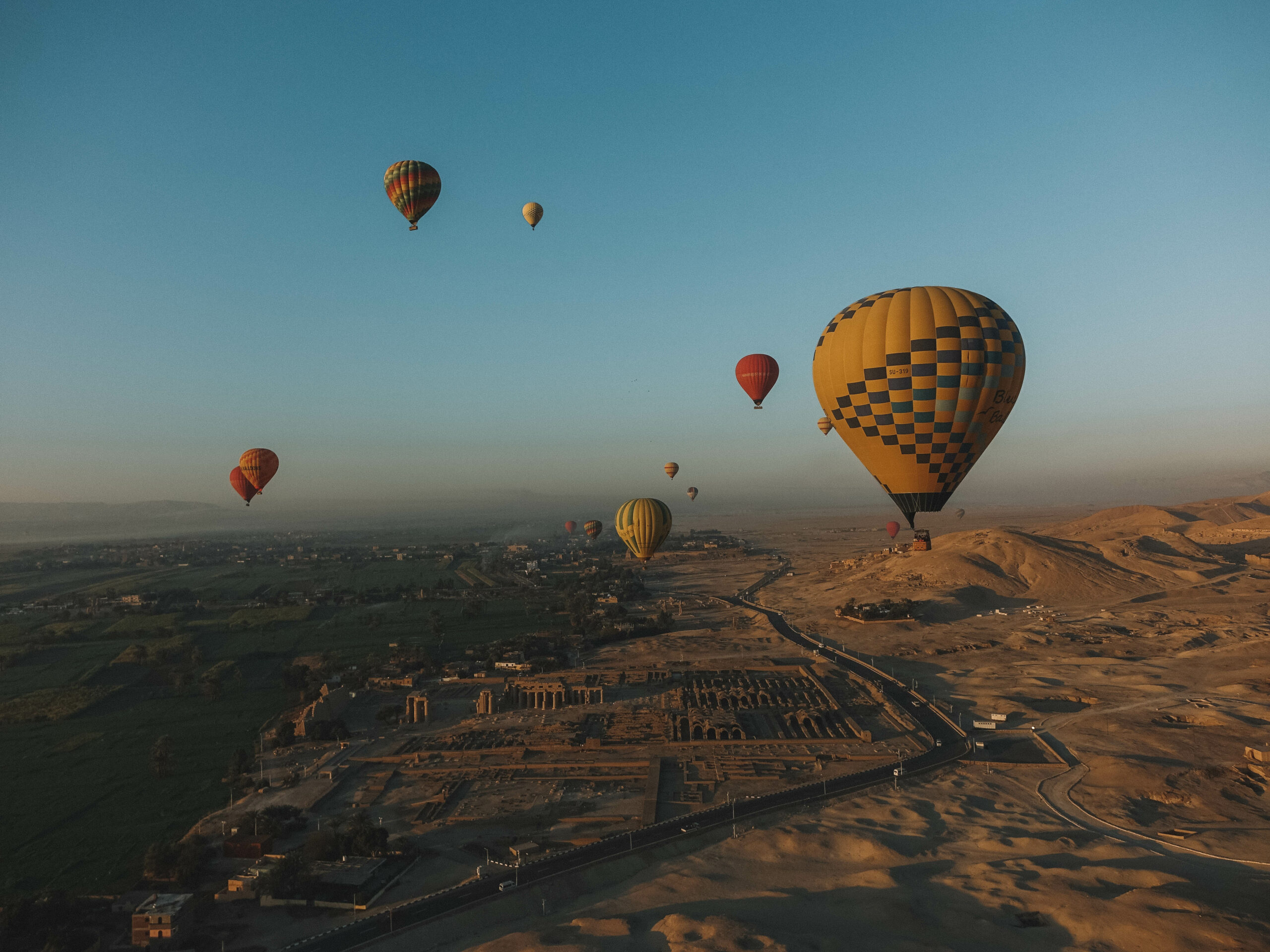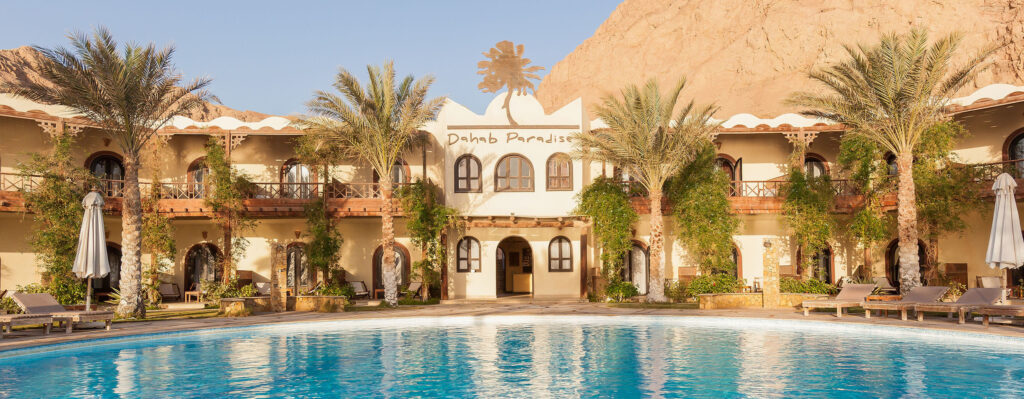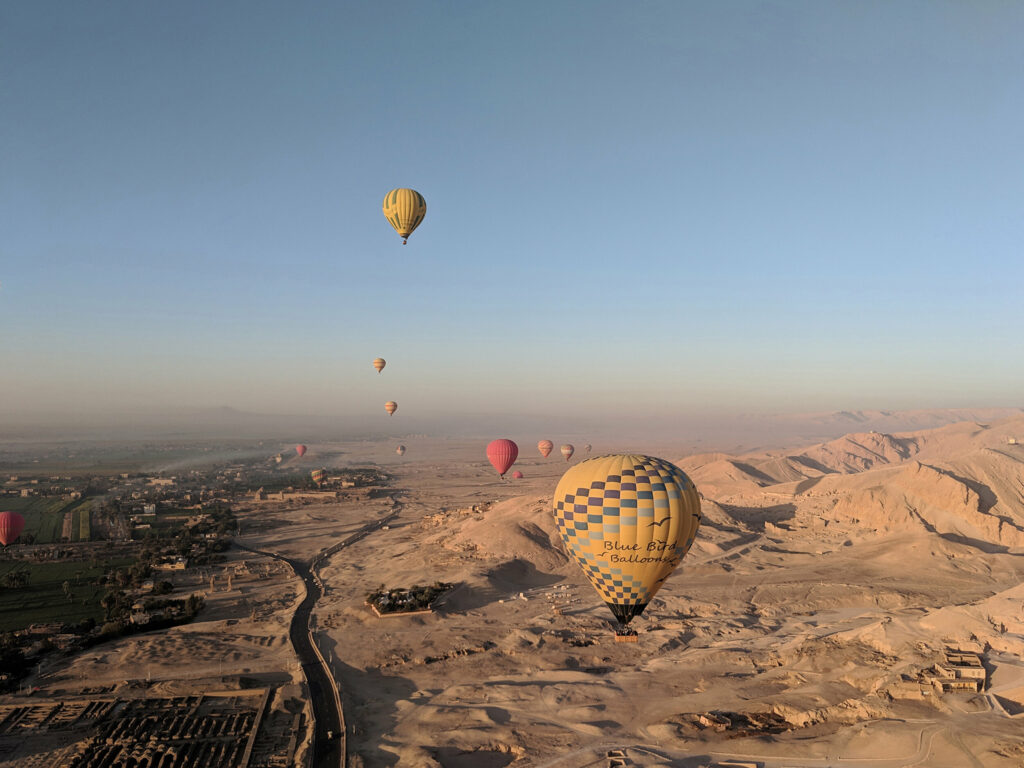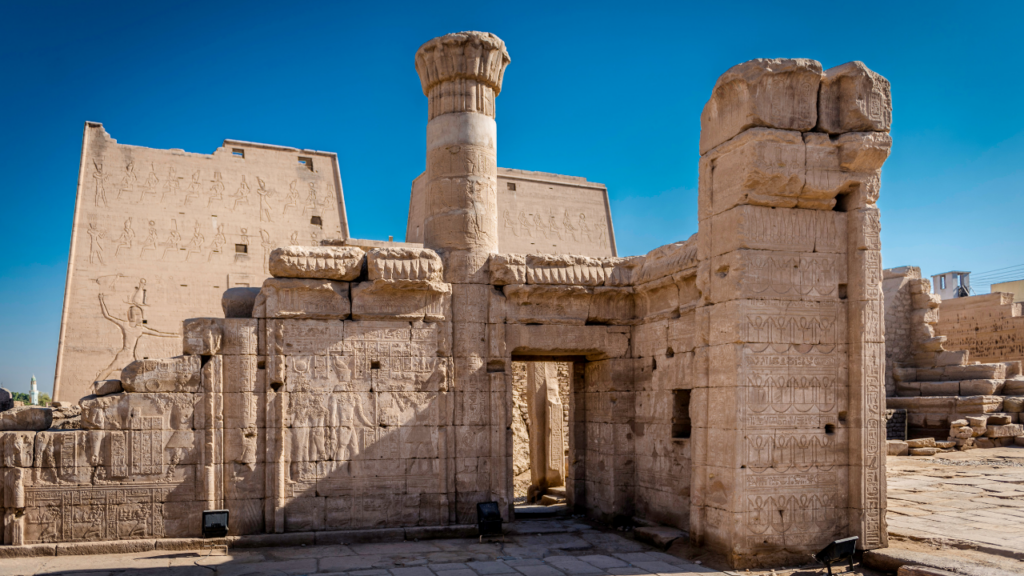In this guide, I’m sharing 15 things you have to do in Luxor! Luxor, in my opinion, has the most to see and do in all of Egypt. And there are plenty of temples outside of Luxor to see as well. Find out which of these 3-day trips you should take from Luxor as well.
There is so much to do in Luxor, which is why I’ve decided to create this list, to help you prioritize and see exactly what you’d like during your trip. This post is created with independent travelers in mind. I don’t necessarily mean solo travelers, though I do touch on that, I just mean travelers that aren’t going with a massive tour group.
Read Next | Solo travel guide to Egypt
When it comes to getting to Luxor, you have a lot of options. You can fly, take a bus or train from Hurgada and Cairo.
Luxor is known as the land of temples. There are more temples located in and around Luxor than anywhere else in Egypt and they are all incredible. In Luxor, you’ll find the most famous temples which are the Valley of the Kings and the Temple of Luxor. You’ll also find my personal favorites, Karnak Temple and the Temple of Hatshepsut.
There are also lesser-known temples that you can get to from Luxor in just a couple of hours. The options are endless so I’ve created this guide to help you make sure you see the best of the best without missing anything.
The Top 15 Things to do in Luxor


Valley of the Kings
The Valley of the Kings is one of the most important excavation works of our time. It’s been on my bucket list ever since learning about the ancient Egyptians in school as a kid. (Did you know: I wanted to be an archeologist when I grew up simply because of the discoveries made at Valley of the Kings?) It has some of the most well-preserved and famous burials in Egyptian history.
I chose to go to the Valley of the Kings independently and when I got there, I realized that it was not going to be a straightforward visit. It’s extremely confusing when you first arrive and you need to have your trip planned in advance.
I’ll be writing a full guide for visiting the Valley of the Kings and if you want to be the first to know when it’s published, hop on my mailing list!
Temple of Luxor

When I visited the Temple of Luxor, I had a guide with Experience Egypt tours. They picked me up and took me through the Temple of Luxor and Karnak Temple. I chose to visit these two places with a guide because I didn’t know much about their history, so I wanted someone along that could inform me.
It’s best to visit early and beat the tour buses. The Temple of Luxor is open from 6am until 10pm each evening.
The Temple of Luxor has a rich history. The temple was built by Amenhotep III (1390-52 BC) but completed by Tutankhamun (1336-27 BC) and Horemheb (1323-1295 BC) and then added to by Rameses II (1279-13 BC) (source: https://discoveringegypt.com/luxor-temple/)
What I found to be extremely interesting was that for thousands of years, the Temple of Luxor sat beneath the streets of Luxor with other buildings and people living directly above it. Most interestingly is that a Mosque sits atop some of the ruins, which has now been deemed history as well, so they’ve just left it and haven’t excavated the rest of the temple.
Also, back in the day Karnak Temple and the Temple of Luxor were connected by the Avenue of Sphinxes which now only a few survive.
While your visiting, make sure that you spend a bit of extra time exploring the back rooms of the temple. There’s a unique figure on the walls there. I’ll let you see for yourself!
Tickets cost £120EGP (£5) and photography is free. Again, a tripod will cost £20EGP (£1). Tripod tickets are per visit, per site.
Karnak Temple



Karnak Temple was my favorite. It was once connected to the Temple of Luxor with the Avenue of the Sphinxes and when you enter the temple, you walk through the remains of that Avenue.
There are 134 columns, each column is 97 feet tall and weighs 323 tonnes. You’ll notice that at the top of the pillars, next to the walkway, the leaves are open. This represents the Papyrus nearest to the Nile. When you walk further away from the walkway, the leaves of the Papyrus as the tops are closed. I love the tiny details of everything in Egypt! Don’t forget to turn anti-clockwise 6 times for good luck around the scarab!
There are cafés inside this temple by the lake and beyond all the hustle, taking a moment to sit here with a drink if you would like. In the heat of Egypt, it’s important to take your time and drink plenty. Grab shade every chance you get as well!
Top Tip: a lot of the temple is closed off to the public, but for a small baksheesh, the guards will let you see forbidden parts!
Opening hours are from 6am – 5pm, tickets cost £150EGP (£6.50), and photography is free. Tripods are allowed but tickets are £20EGP (£1).
Temple of Hatshepsut

Hatshepsut was known as the ‘Woman who was the King’. She was the longest-reigning female pharaoh in Egypt and she was an all-around badass. She reigned for 20 years (seriously unheard of for a woman) and mainly wore a man’s crown and clothing. In her statues, she also chose to be depicted as a man (I think that’s because she wanted to be viewed as an equal to other Pharaohs).
What I love about Egypt, was that these temples weren’t just built to be beautiful, they were also built with the sun, the stars, and the moon in mind. For example, the axis of Hatshepsut’s temple aligns directly with the Winter Solstice sunrise. It’s pretty incredible and that’s why if you’re in Egypt in December it will be PACKED.
The price of entry is £100EGP (£4), photography is free but tripods cost £20EGP (£1).
I took a taxi to the Temple of Hatshepsut and on the way home, we were able to visit the next thing on my list…
Colossi of Memnon
These are two massive stone statues that are the only remaining pieces of what was, the Temple of King Amenhotep III. All you need is a quick stop, have a walk around the massive statues, and take a couple of photos. They’re really worth stopping at.
Visiting is free but if you want to take photos with a tripod – you are going to have to pay.
Valley of the Queens
In ancient times, it was known as Ta-Set-Neferu, meaning ‘the place of beauty’. I decided to visit because not as many people go, Valley of the Kings is more popular.
Here you can see the tombs of famous queens, princesses, and female pharaohs. The most popular being QV66 Queen Nefertari, the famous wife of Ramses II (£1000EGP entry).
The normal ticket for three other tombs £160 EGP (£6).
Dinner across the river at Aladdin’s Kingdom by Banana Island
Banana Island is a popular attraction that Egyptians will tell you you have to come to see while you are in Luxor. It’s a ‘zoo’ with crocodiles and a plantation of bananas and sugarcane.
I actually would recommend skipping banana island though and instead of having a lovely dinner at the Aladdin’s Kingdom restaurant instead. I stayed on the West Bank and was wandering through the local village when I found Aladdin’s Kingdom. The owner is incredible and made me a special dessert without any dairy (because of my diet), then he didn’t even charge me for it. He also sent me home with a bunch of bananas.
Hot Air Balloon Ride

Riding in a hot air balloon was on the top of my list for traveling in Luxor. I wanted to ride in a Hot Air Balloon as the run rose over the Valley of the Kings and that’s exactly what I was able to do. It was incredible and while I was a bit worried about safety, my guide was knowledgeable and the company I went with was highly recommended. If you’d like to know how my experience was, hop on my mailing list to be the first to know when I post about it.
Madinat Habu
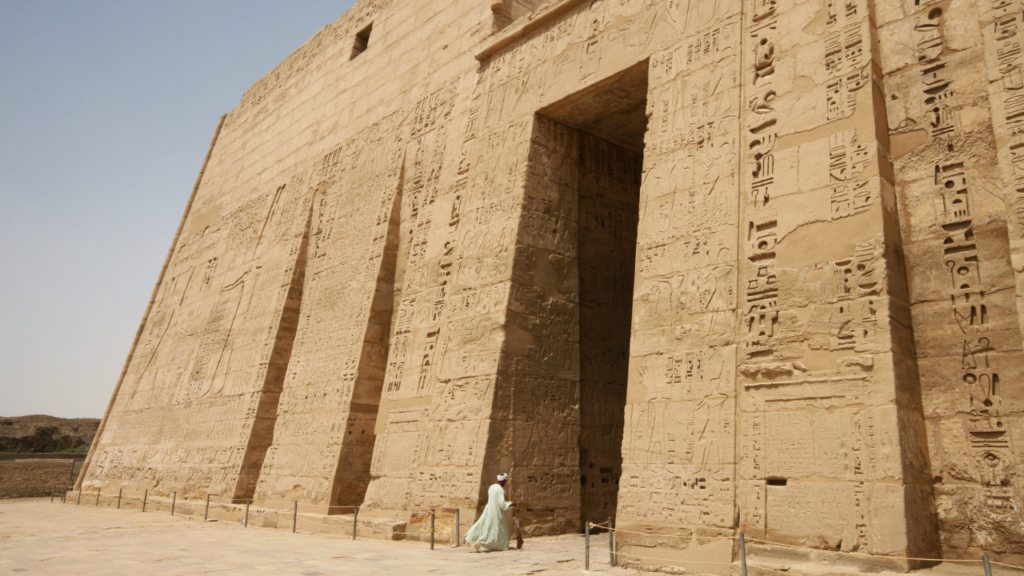
While Madinat Habu often gets skipped by tour companies, it’s actually one of the most well-preserved colorful temples in Luxor. I love seeing the beautiful statues and carvings from the ancient Egyptians but it’s even better when you can see color preserved from the paint.
Back in the day, these temples were intricately painted in bright, stunning colors from top to bottom. Blue is the main color preserved in the majority of temples and Madinat Habu is a great place to see that.
Madinat Habu is the mortuary temple of Ramses III. Unlike his tomb at Valley of the Kings to celebrate his passing into the underworld, this temple is meant to celebrate his life achievements.
Tickets cost £80EGP (£3) and photography is free. You will buy tickets at a central counter which is a little far from the temple itself. Tripod tickets are £20EGP (£1) so make sure you buy this at the counter before you go.
Shop for Alabaster
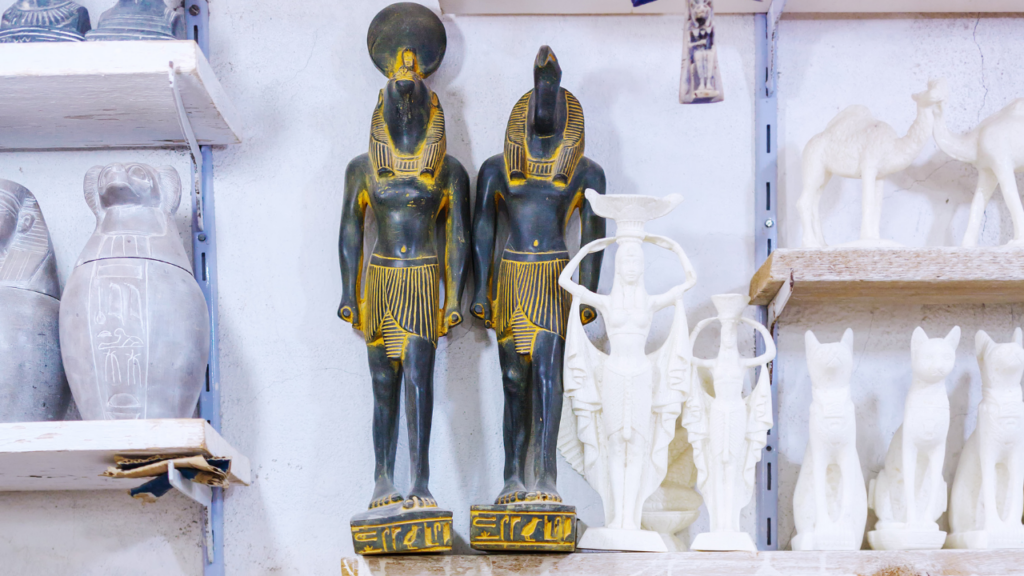
One thing you have to do before you leave is shop for Alabaster. While you’re there you’re going to get offered Alabaster at every shop you pass. There will even be Egyptians offering it to you on the street. I recommend that instead, you go to a local Alabaster Factory. There you can see how the Alabaster is carved and shaped.
You’ll get a chance then to learn about the process and see the difference between something that has been hand carved and something that’s been machine-made. Please go to an official government-approved tourist shop or institute to buy products. The price may be higher but you’ll know that it comes from Egypt, it’s made by local craftsmen and it’s a genuine product.
Top tip: Don’t shop with your guide! They usually have a relationship with the shop and will receive a commission percentage of what you bought. So, knowing that, the shop owner will bump up the price. If you’re on a tour group, this usually isn’t the case.
Light and Sound Show at Karnak Temple
I was told by multiple people throughout Egypt that when I was in Luxor I have to go to the Light and Sound Show at Karnak Temple. You get the chance to walk around the temple and hear the narration as you go. It’s like you are transported back in time. For the grand finale, you sit in the amphitheater on the opposite side of the lake. Here, you can see the whole temple of Karnak light up.
Entry is £250EGP (£11) and worth every penny. The first show isn’t always in English, for showtimes and languages see here. There needs to be a minimum of ten people for the show to go ahead.
Sunset Felucca on the Nile

You haven’t visited Luxor if you didn’t take a Felucca ride at sunset. It’s a beautiful time to be out on the water. The day starts to cool down and peace settles over the city. The Felucca are traditional sailboats, which means in order to go anywhere you need wind. It wasn’t overly windy during our sail, so we mostly just slowly moved up the river a bit before heading back.
I paid for a one-hour private ride for around £300 EGP (£12).
Luxor Museum
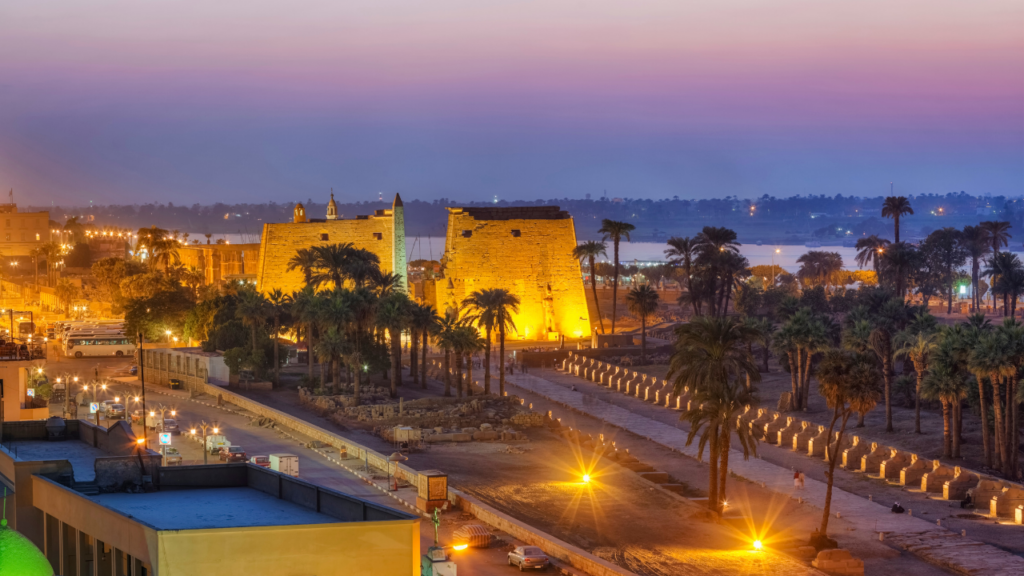
There’s not a museum in Egypt that I think you should skip. If you aren’t going to Egypt for the history then I don’t know what you’re doing there. Egypt has some of the most beautiful and unique histories in the world (in my humble opinion). Also, museums are a great chance to get out of the heat and sun for a few hours.
The museum was opened in 1975 and sits right on the Nile, overlooking the West Bank. It just might be the best museum in Egypt so it’s really worth the visit. The price per ticket is £140EGP (£6) and opening times are 9am – 4pm, and 5pm – 10pm each day.
Wander along the Corniche
The best time would be right around sunset. The air will be cooling down and that beautiful golden hour glow will be settling in on the city. You’ll even get the chance to watch the sunset over the West Bank of the Nile.
Read Next | 3 Temples to Visit from Luxor
Where to stay in Luxor?
There are a couple of options when it comes to staying in Luxor. As with everywhere else in Egypt, you want to make sure that you are staying somewhere that you feel safe. You can stay on the East or West side of the river and each experience is going to be very different.
The East Side of the river is the city center. It’s busy. It’s chaotic.
The West Side of the river is quieter. It’s close to the Valley of Kings and Queens. When I chose where to stay in Luxor, I decided to stay on the West Bank. For me, the West Bank was the obvious choice as I was tired of the hustle and bustle of Cairo. My goal was to experience Luxor fully, but I did want to stay outside of the city.
It’s easy to cross the river. There are plenty of taxi boats and a local ferry that will take you across. The other option is that you can drive around the city and across the Nile.
As for accommodation, there are plenty of choices on the East Side of the river. I would recommend that you look at staying in a hostel. A private room in a hostel is a great way for you to meet people to explore with. Otherwise, check out some of the quieter hotels located on the West Bank.
Find accommodation in Luxor here.
Safety in Luxor
As everywhere in Egypt, I highly recommend that you stick with buddies. When solo traveling through Egypt, my first goal was to make friends that wanted to do the same activities as me every day. This made me feel less alone and be noticed less.
The harassment in Luxor was considerably less than in Cairo, but you still need to take regular precautions. Keep an eye on your bag at all times and don’t respond to the catcalls of strangers. At no time did I feel unsafe while traveling through Luxor.
Cost of Travel in Luxor
🏨 Double room: $10-20 a night
🍛 Meals for a day: $5.48
🥭 Fruit snacks: $1 bunch of bananas
🚰 Drinking water: $.10 for 2L
🚗 Public Transportation: $5.42 per day
Average price per day: $21
